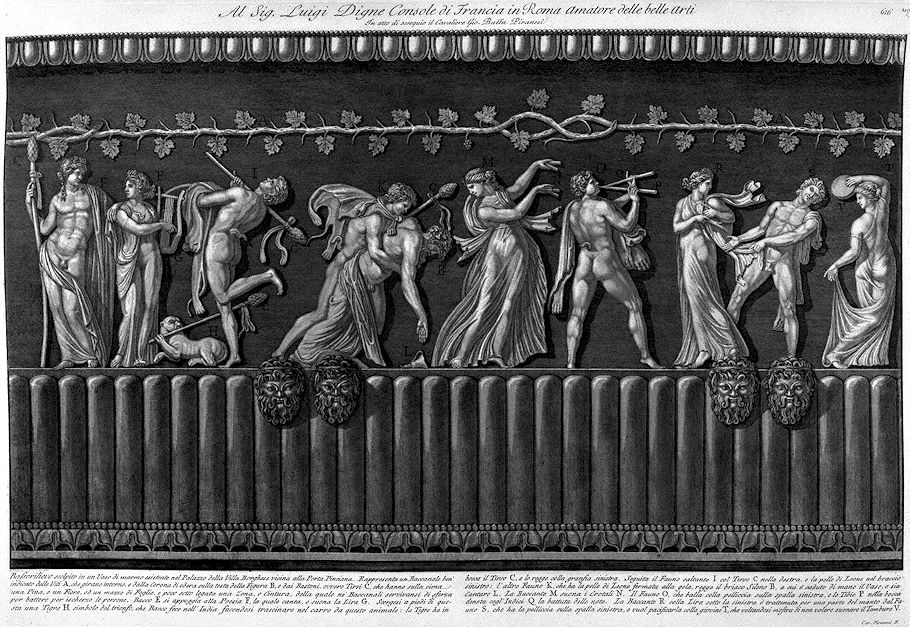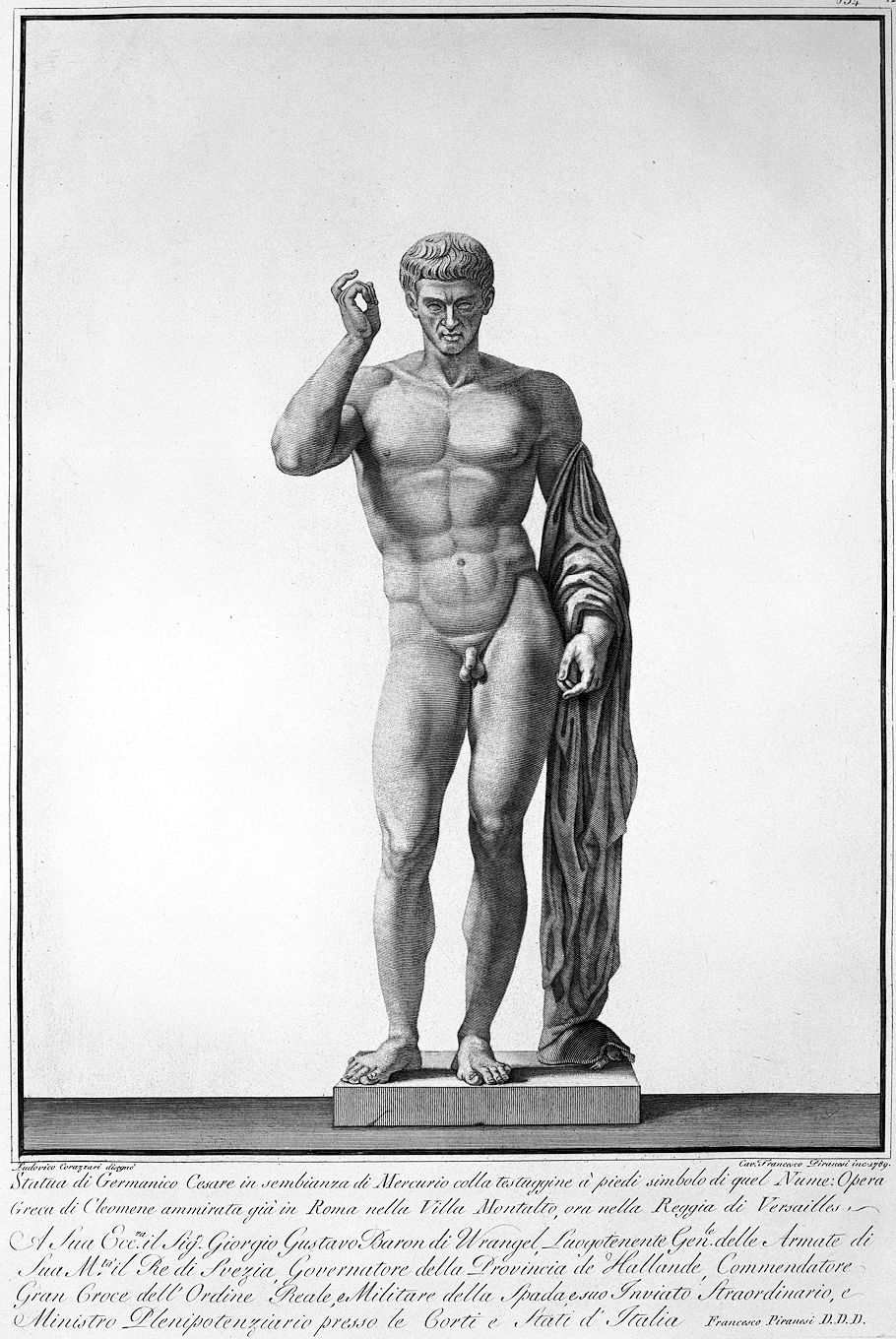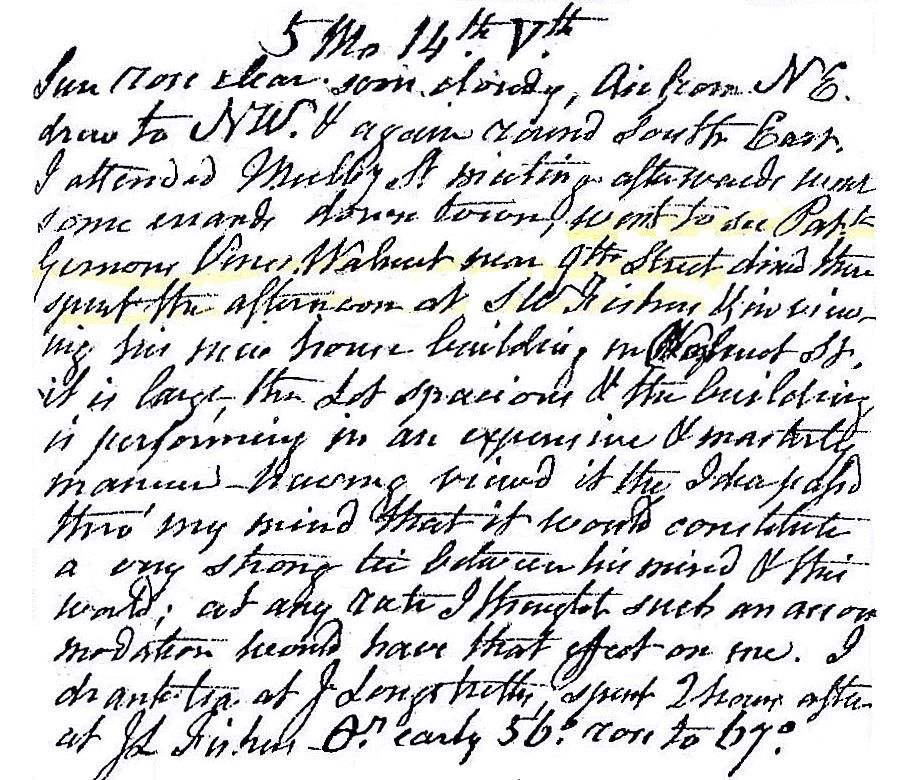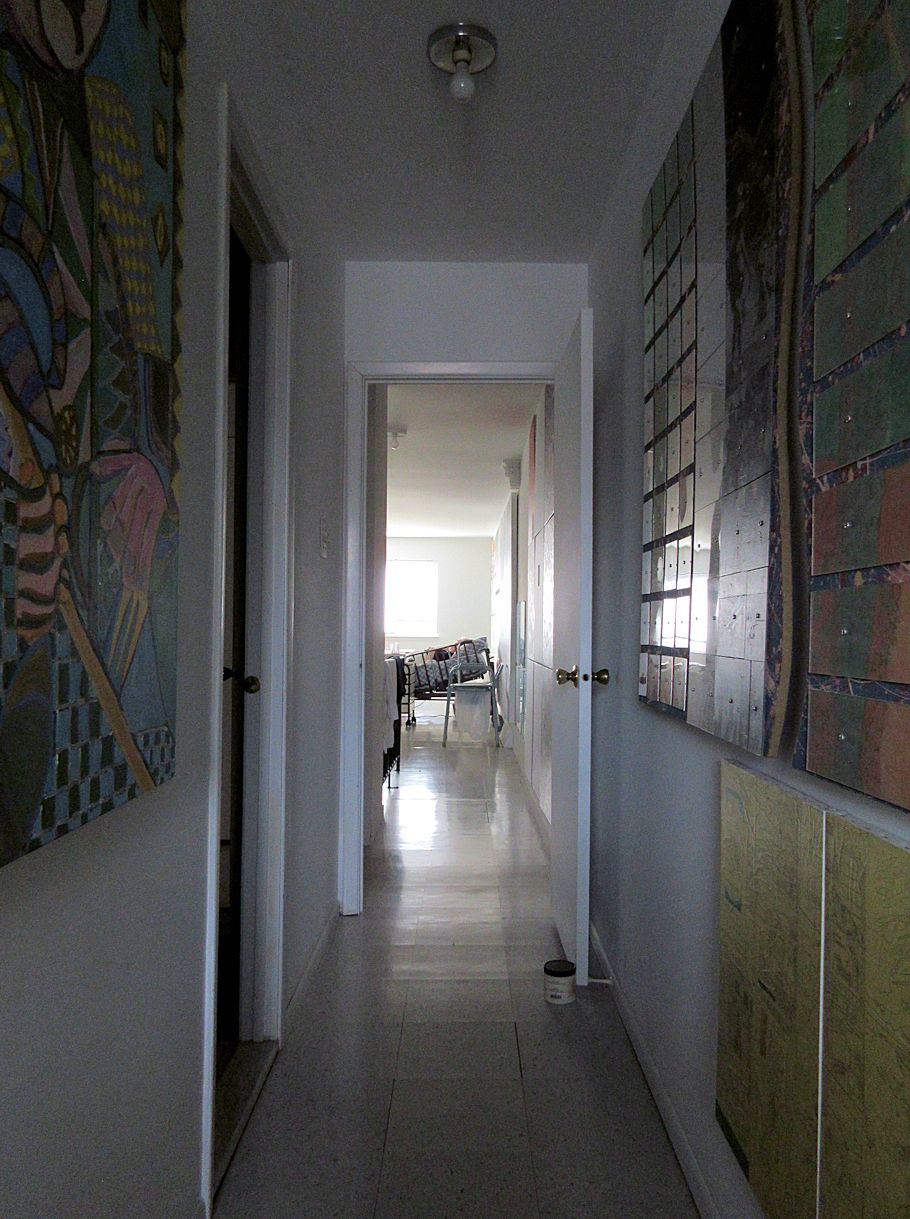14 May 1778 Thursday
Vases, Candelabra, Grave Stones, Sarcophagi. Tripods, Lamps and Ancient Ornaments volume II

To Mr. Luigi Digne Consul of France in Rome Lover of the fine arts
In deed of respect the Knight Gio. Batt(ist)a Piranesi
Bas-relief carved in a marble vase existing in the Palazzo della Villa Borghese near the Porta Pinciana. It represents a Bacchanal well indicated by the Vines A, which turn around, and by the Crown of ivy on the head of Figure B, and by the Sticks, or Thyrsis C, which have on their top a Pina, or a Flower, or a bunch of Leaves, and a little below bound a Zone, or Belt, of which in the Bacchanalia they used a whip to beat people as a joke. Bacchus E leans on the Poetry F, which sings, and plays the lyre G. At the foot of this we see a Tiger H, symbol of the triumph that Bacchus achieved in India by letting himself be dragged in the chariot by this animal: the Tiger has the Thyrsus C, and holds it with the left hand. Followed by the Leaping Faun I with the Thyrsus C in his right hand and the skin of a Lion on his left arm: the other Faun K, who has the skin of a Lion held at the throat, is holding the drunkard Silenus B, whose hand has dropped the Vase , or let it be Cantaro L. The Bacchante M plays the Crotali N. The Faun O, who dances with the fur on his left shoulder, and the Tibiae P in his mouth denotes the beat of the notes with the Indices Q. The Bacchante R with the lyre under her left hand is held back for part of the mantle by the Faun S, who has the fur on his left shoulder, and wants to pacify her with the young T, who, turning around, shows that he does not want to play the Drum V.
Cav. Piransei F.
14 May 1784
Between 1783 and 1784 Gustavus III visited Rome and bought a series of bronzes together with other objects which were sent to Sweden by Francesco Piranesi who, in an undated letter which must have been written before December 1784, announced to Fredenheim: ‘J’ai déjà envojé les 20 petites figures en bronze en caisses le 20 du May passe come aussi les 4 poinçons de la Reine Christina, les habits, et les livres de S. M.’ (I have already sent the 20 small bronze figures in crates on the 20th of May, as well as the 4 hallmarks of Queen Christina, the clothes, and the books of S. M.). The twenty bronzes were those that the King had chosen in April 1784. Piranesi’s disappointment that Gustavus III did not visit his studio is palpable in one of his many letters to Fredenheim. He accused the sculptor Sergel of not having encouraged the King to visit Piranesi’s studio where he could have found works of art of a standard fit for a king. In several letters he berates Sergel, whom he accused of having been over-influential in the King’s choice of works of art. Piranesi’s criticisms passed quickly from the artistic to the personal, and on 14th May 1784 he inveighed against Sergel to his friend: ‘C’est ici Mon cher Ami, que je dois me plaindre de ce Sculpteur enflé, superbe, qui ayant reçu toutes mes politesses comm’un tribut dû a son mérite au lien de ses récompenses a bouleversé tous mes affaires, s’est moqué de presque tous les artistes, et n’a cherché qu’un vil intérêt. Voilà tout ce qu’on dit de lui par la ville’ (It is here My dear Friend, that I must complain of this swollen, superb Sculptor, who having received all my courtesies as a tribute due to his merit in connection with his rewards has upset all my affairs, has mocked of almost all artists, and has sought only base interest. That's all the city says about him.). --Chiara Teolato
30-31 y.o. Francesco Piranesi 1789
Collezione delle piu belle statue di Roma

Statue of Germanicus Caesar in the guise of Mercury with the tortoise at his feet symbol of that God: Greek work by Cleomene already admired in Rome in Villa Montalto, now in the Palace of Versailles.
To His Excellency Mr. George Gustav Baron of Wrangel, Lieutenant General of the Armies of His Majesty the King of Sweden, Governor of the Province of Hallande, Commander Grand Cross of the Royal Order, and Military of the Sword, and his Extraordinary Envoy, and Minister Plenipotentiary to the Gorti and States of Italy
Francesco Piranesi D.D.D.
Ludovico Corazzari drawn Francesco Piranesi engraved 1789.
14 May 1812 Thursday

Sun rose clear, soon cloudy, air from NE drew to NW and again round South East. I attended Mulberry Street Meeting, Afterwards went some errands downtown. Went to see Patrick Gernone[?] Vine[?] Walnut near 9th Street dined there. Spent the afternoon at SW Fisher's and in viewing his new house building in Walnut Street. It is large, the lot spacious and the building is performing in an expensive and masterly manner--having viewed it, the idea passed through my mind that it would constitute a very strong tie between his mind and this world; at any rate I thought such an accommodation would have that effect on me. I drank tea at J Longstreth's, spent 2 hours after at JL Fisher's. Temperature early 56° rose to 67°.
14 May 1998
Encyclopedia Ichnographica
...catalogue all the source data per building. ...collect everything--textual references, bibliographical notes, analysis notes, CAD drawings, and Piranesi's drawings.
...refer to the above project as the Encyclopedia Ichnographica.
14 May 1999
discovery
Discovery of the two states of the Ichnographia today at Penn's Fine Arts Library.
14 May 2004
bilocation, bilocation, bilocation
Louis I. Kahn, with Helena, Eutropia, and Catherine de Ricci, is visiting Israel today--a modern birthday visit. Melania the Elder and Melania the Younger saw to all the prior arrangements--"They gave up all their Roman wealth to die (there) in poverty, you know." Mamre (near Hebron), specifically the site of Abraham's altar, is their last stop, and they all know that Eutropia is going to get very emotional.
"I consider it necessary to detail the proceedings of Constantine in relation to what is called the oak of Mamre. This place is now called Terebinthus, and is about fifteen stadia distant from Hebron, which lies to the south, but is two hundred and fifty stadia distant from Jerusalem. It is recorded that here the Son of God appeared to Abraham, with two angels, who had been sent against Sodom, and foretold the birth of his son. Here the inhabitants of the country and of the regions round Palestine the Phoenicians, and the Arabians, assemble annually during the summer season to keep a brilliant feast; and many others, both buyers and sellers, resort thither on account of the fair. Indeed, this feast is diligently frequented by all nations: by the Jews, because they boast of their descent from the patriarch Abraham; by the Pagans, because angels there appeared to men; and by Christians, because He who for the salvation of mankind was born of a virgin, afterwards manifested Himself there to a godly man. This place was moreover honored fittingly with religious exercises. Here some prayed to the God of all; some called upon the angels, poured out wine, burnt incense, or offered an ox, or he-goat, a sheep, or a cock. Each one made some beautiful product of his labor, and after carefully husbanding it through the entire year, he offered it according to promise as provision for that feast, both for himself and his dependents. And either from honor to the place, or from fear of Divine wrath, they all abstained from coming near their wives, although during the feast these were more than ordinarily studious of their beauty and adornment. Nor, if they chanced to appear and to take part in the public processions, did they act at all licentiously. Nor did they behave imprudently in any other respect, although the tents were contiguous to each other, and they all lay promiscuously together. The place is open country, and arable, and without houses, with the exception of the buildings around Abraham's old oak and the well he prepared. No one during the time of the feast drew water from that well; for according to Pagan usage, some placed burning lamps near it; some poured out wine, or cast in cakes; and others, coins, myrrh, or incense. Hence, as I suppose, the water was rendered useless by commixture with the things cast into it. Once whilst these customs were being celebrated by the Pagans, after the aforesaid manner, and as was the established usage with hilarity, the mother-in-law of Constantine was present for prayer, and apprised the emperor of what was being done. On receiving this information, he rebuked the bishops of Palestine in no measured terms, because they had neglected their duty, and had permitted a holy place to be defiled by impure libations and sacrifices; and he expressed his godly censure in an epistle which he wrote on the subject to Macarius, bishop of Jerusalem, to Eusebius Pamphilus, and to the bishops of Palestine. He commanded these bishops to hold a conference on this subject with the Phoenician bishops, and issue directions for the demolition, from the foundations, of the altar formerly erected there, the destruction of the carved images by fire, and the erection of a church worthy of so ancient and so holy a place. The emperor finally enjoined, that no libations or sacrifices should be offered on the spot, but that it should be exclusively devoted to the worship of God according to the law of the Church; and that if any attempt should be made to restore the former rites, the bishops were to inform against the delinquent, in order that he might be subjected to the greatest punishment. The governors and priests of Christ strictly enforced the injunctions contained in the emperor's letter."
--Salminius Hermias Sozomen, Ecclesiastical History, Book II, chapter 1 (circa 443 AD).
Eutropia tells of how the only time she was at the festival at Mamre was when she was still married to her first husband (i.e., before her marriage to Maximian). She was there along with her husband and their daughter, Theodora. When she wrote to Constantine about the festivals at Mamre, it was via her youthful recollection. She finds it comically tragic how subsequent historians assumed that she wrote to Constantine of Mamre from Mamre itself, and how this misinterpretation engendered a whole series of historical inaccuracies.
14 May 2008
True discussion/argument among classmates
Humans are perfectly capable of knowing the truth, however, humans that are openly truthful remain a rarity.
If real truthfulness didn't exist, then there wouldn't be anything to lie about.
14 May 2023 Sunday

17:50
|